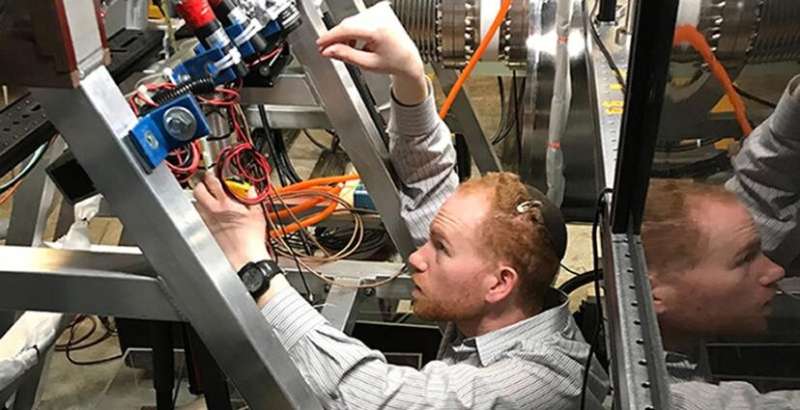
The existence of neutrons produced through thermonuclear reactions from a sheared-flow stabilizing Z-pinch device has been proven by research led by Lawrence Livermore National Laboratory.
The researchers used advanced computer modeling techniques and diagnostic measurement devices to solve a decades-old problem of distinguishing between thermonuclear reactions and ion beam-driven instabilities.
The team had previously shown that the sheared-flow stabilizing Z-pinch devices were consistent with thermonuclear production.
The Portable and Adaptable Neutron Diagnostics (PANDA) team is doing research under the Department of Energy Advanced Research Projects, and the principal investigator of the team said this is proof that thermonuclear fusion produces these neutrons.
The paper shows how the lab's broad range of research is benefiting the larger fusion community beyond the major advancements made by the NIF.
The research only focused on one device, but the general techniques and concepts are applicable to a lot of fusion devices.
The NIF experiment yielded a record 1.35 megajoules of energy. The National Academy of Sciences and the National Nuclear Security Administration define the threshold of ignition as when a NIF implosion produces more fusion energy than the amount of laser energy delivered to the target. The shot was preceded by progress made by the researchers.
The sun, stars and thermonuclear weapons all have fusion. NIF's experiments focus 192 laser beams on a small target to compress and heat partially frozen hydrogen isotopes inside a fuel capsule, creating an implosion replicating the conditions of pressure and temperature found only in the cores of stars and giant planets and in exploding nuclear weapons. The Z-pinch machines use a powerful magnetic field to confine fusion.
The Z-pinch concept has been a theoretical model since the 1930s. It had a long history of terrible instabilities that hindered the ability to generate the conditions needed to achieve a net fusion energy gain.
The sheared-flow stabilizing Z-pinch concept was developed by researchers at the University of Washington. Z-pinch devices with sheared-flow stabilization use electrical pulse current to generate a magnetic field that flows through a column of plasma to reduce fusion disrupting instabilities.
The problem with instabilities is that they do not create a viable path to energy production.
The fusion Z-Pinch Experiment (FuZE) project was awarded a $5.28 million ARPA-E cooperative agreement to test the physics of pinch stabilization at higher energies and pinch current.
Under the ARPA-E cooperative agreement, the researchers focused on diagnostics that measured the neutron emissions produced during the fusion process, including the spatial locations and time profiles of those emissions. The ARPA-E fusion capability team program aims to combine the expertise of national laboratories with the agility of private companies.
When the FuZE cylinder's radius was narrowed, it would cause dips in the plasma that generated stronger magnetic fields that would cause the plasma to pinch inwards more in certain spots than in others. Like the pinched ends of a popular tubular minced meat, those unwanted instabilities would create beams of faster ion that produced faster ion that could be confused with thermonuclear-produced neutrons.
Two plastic scintillator detectors were placed outside of the device to measure the amount of neutrons that came out of the Z-pinch chamber.
We showed that the emitted neutron energies were the same at different points around the device.
The analysis included creating histograms of the neutron pulse detected by the two scintillators and comparing them using methods such as Monte Carlo computerized simulations that examine all possible outcomes.
The idea of using histograms of individual neutron pulse energies to measure the anisotropy is a new technique. We have been working with UC Berkeley, which has helped us to develop the modeling capability to iron out the uncertainties in the measurements. We are not just looking through the data.
The paper was published in November and stems from a talk Mitrani gave at the American Physical Society-Division of Plasma Physics annual meeting in 2020.
They were joined by other people, such as Joshua Brown and Thibault Laplace of UC Berkeley.
A Seattle startup named Zap Energy was spun off from the research.
As Zap Energy continues experiments, there are more detailed measurements taken by 16 detectors.
We don't know what surprises might arise, so we want to be involved. We want to be able to show that it is possible to maintain a high quality and stable pinch when the current goes up.
More information: James M. Mitrani et al, Thermonuclear neutron emission from a sheared-flow stabilized Z-pinch, Physics of Plasmas (2021). DOI: 10.1063/5.0066257 Journal information: Physics of Plasmas Citation: Scientists confirm thermonuclear fusion in a sheared-flow Z-pinch device (2022, March 7) retrieved 7 March 2022 from https://phys.org/news/2022-03-scientists-thermonuclear-fusion-sheared-flow-z-pinch.html This document is subject to copyright. Apart from any fair dealing for the purpose of private study or research, no part may be reproduced without the written permission. The content is provided for information purposes only.